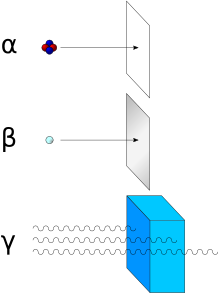Half-life shift
The half-value layer or half-value thickness is the thickness of a penetrated material which, in the case of electromagnetic radiation such as gamma or X-ray radiation , reduces the radiation intensity - and thus in particular the dose rate - by half. Like the absorption coefficient, the half-value thickness depends on the specific properties of the material and the photon energy of the incident radiation.
The half-value thickness can only be used for the approximate dimensioning of simple shielding , since various physical effects ( e.g. dose build-up , scattering , Skyshine effects ) are not taken into account. Exact results require, for example, Monte Carlo simulations or transport calculations (numerical calculations based on Boltzmann's transport equation ).
The term tenth value thickness be considered as analogous: traversing this thickness reduces the intensity to one-tenth of the original value.
Exponential decrease with the penetration depth

In contrast to alpha and beta radiation, gamma radiation does not have a maximum range . The intensity of the gamma radiation is continuously weakened as it passes through matter.
The ratio of the dose rate , which is determined in the beam path without shielding, and the dose rate of the unscattered radiation at the same location with shielding material of the thickness is referred to as the (material) attenuation factor of the unscattered radiation:
The formula applies to the reciprocal attenuation factor
- .
Here denotes the attenuation coefficient. The following applies by definition to the half-value layer thickness
- .
Thus, the half-value layer thickness results from the attenuation coefficient by
or the other way around
- .
This gives the dose rate behind a shield of any thickness
- .
Half-value layer thickness for gamma radiation
| air | lead | water | Alu | iron | graphite | concrete | Lead glass | acrylic | |
|---|---|---|---|---|---|---|---|---|---|
| E γ in MeV | in meters | in millimeters | |||||||
| 0.1 | 35 | 0.107 | 41 | 15.2 | 2.4 | 20.3 | |||
| 0.2 | 44 | 0.62 | 51 | 21.1 | 6th | 25th | |||
| 0.3 | 50 | 1.56 | 58 | 24.8 | 8th | 28.8 | |||
| 0.4 | 56 | 2.65 | 65 | 27.8 | 9.4 | 32.4 | |||
| 0.5 | 62 | 3.85 | 72 | 30.5 | 10.5 | 35.4 | 33 | 13 | 70 |
| 0.6 | 67 | 4.92 | 77 | 33 | 11.5 | 38.3 | |||
| 0.8 | 76 | 6.9 | 88 | 37.7 | 13.2 | 44 | |||
| 1 | 84 | 8.7 | 108 | 42 | 14.7 | 48 | 50 | 24 | 90 |
| 1.5 | 101 | 11.7 | 121 | 51 | 18.1 | 59 | |||
| 2 | 121 | 13.4 | 141 | 60 | 20.8 | 69 | |||
| 3 | 145 | 14.6 | 175 | 73 | 24.4 | 87 | |||
| 4th | 174 | 14.7 | 204 | 83 | 26.7 | 101 | |||
| 5 | 196 | 14.4 | 230 | 91 | 28.1 | 115 | 100 | 45 | 200 |
| 6th | 213 | 14.1 | 251 | 97 | 28.9 | 125 | |||
| 8th | 242 | 13.4 | 286 | 106 | 29.7 | 144 | |||
| 10 | 265 | 12.6 | 315 | 112 | 29.7 | 158 | |||
literature
- Hans-Gerrit Vogt, Heinrich Schultz: Basics of practical radiation protection . 6th edition. Carl Hanser Verlag GmbH & Co. KG, Munich 2011, ISBN 978-3-446-42593-4 .
Individual evidence
- ^ German-Swiss Association for Radiation Protection (FS) e. V .: Data and facts on handling radionuclides and on decontamination in radionuclide laboratories , loose-leaf collection, Part 1.4 Shielding , October 1997
- ↑ Andreas Kratzer (Technical University of Munich): Physical internship for mechanical engineering: "Radioactivity" ( Memento of the original from May 26, 2017 in the Internet Archive ) Info: The archive link was inserted automatically and has not yet been checked. Please check the original and archive link according to the instructions and then remove this notice.











